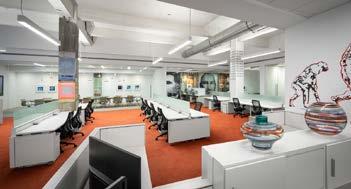
5 minute read
Connecticut
H.F. Lenz Develops ‘Building Community’ Initiative, Continues Market Expansion Efforts
Middletown, CT – H.F Lenz Company, a multi-discipline engineering firm, has been developing a community-based initiative set to launch this year, the same year in which it will be celebrating its 75th year anniversary and the 10 year anniversary of its Middletown office.
The firm’s New England regional manager, Scott Kraynak, P.E., explains, “We felt strongly about giving back to the community that has been so welcoming and so good to us. We’re rolling up
Scott Kraynak our sleeves and getting more involved with this new initiative.” The Building Community initiative aims to serve struggling segments of the Middletown community through a supporting platform of local AEC industry contacts.
Leaders of the firm say their efforts to consider community involvement as an integral aspect of their mission statement is an important step in progress toward a more equitable and inclusive AEC industry, and that the launch of this initiative is an example of the firm’s ongoing commitment to helping further develop the community, having built solid client relationships in multiple markets including data centers, higher education, science and technology, healthcare, sports and recreation, K-12 and mission critical. The team at H.F. Lenz continues to expand their partnerships on a number of projects they say have already directly improved and served local communities across New England, such as their MEP design work alongside Connecticut architectural firm, S/L/A/M, on the multiaward-winning Sacred Heart University’s Bobby Valentine Health and Recreation Center Project, Yale University, and UCONN.

STRUCTURAL, FIRE PROTECTION, PLUMBING, MECHANICAL + ELECTRICAL ENGINEERING
HIGHER EDUCATION HEALTHCARE SCIENCE + TECHNOLOGY SPORTS + RECREATION DATA CENTERS K-12
Celebrating the 10th Anniversary of our CONNECTICUT OFFICE!
MIDDLETOWN, CT HFLENZ.COM 860.316.2124
Planners Selected for Redevelopment
Middletown, CT – City of Middletown mayor, Ben Florsheim, announced that the City of Middletown has elected to hire architecture and urban design firm Cooper Robertson for the development of a master plan for riverfront redevelopment. The team will also include Langan, an engineering and environmental services firm, and Karp Strategies, a firm dedicated to community-driven economic development strategy.
“I am thrilled to be getting the riverfront master plan underway, and so excited for the work this community is going to do together with Cooper Robertson and team,” Florsheim said. “The level of talent, vision, and experience that they bring to the table matches the extraordinary potential and opportunity that exists on our riverfront, and their strong focus on community engagement will ensure that this will be a peopledriven process leading to the outcome we all want: a riverfront that has something for everyone.”
In the coming weeks, the city will announce the beginning of the public engagement initiative to introduce the
Mayor Ben Florsheim riverfront master planning team to the community at large, establish a timeframe and budget, and start the process of creating an action-oriented plan for the future of Middletown’s riverfront.
“Cooper Robertson understands the importance of putting the public and community at the center of the planning process, and we look forward to working together with residents and City of Middletown staff to develop a riverfront plan that is sustainable in the broadest sense of the word: environmentally, socially and economically,” said Mike Aziz, Cooper Robertson’s project director.
Trends and Hot Topics Return to Work Drives Increased Demand for Workplace Modifications
Boston – SDI Architecture, an international architectural and interior design firm with offices in Boston and India, reports it is seeing the impact of Zoom fatigue on both office design and office location firsthand.
Recently, the Boston firm has experienced a significant increase in demand for modifications to workplaces as companies prepare for a larger number of employees returning to the office. The reason for the demand for modifications, according to the firm’s representatives, is that companies are looking for ways to keep employees and employers safe as COVID-19 continues to spread while the country waits for vaccination numbers to reach a point where communities have achieved herd immunity.
“Earlier in the pandemic we saw a significant change in the areas where new construction was taking place as businesses moved out of the city and into suburban office parks which were less expensive and provided more outdoor space,” said Ben Williams, owner of SDI Architecture. “Now we are getting requests from those same companies to further modify these offices to allow for more employees in their workplaces at

According to representatives of SDI Architecture, Zoom fatigue is one of the factors driving workers back to the office as the pandemic restrictions ease, and it is requiring companies to modify their office space to satisfy a new hybrid style of work: collaborating in the office while individual work is done at home. / Photos by Trent Bell the same time, while maintaining safe distances and interactions.”
SDI reports a number of factors fueling the employee move back to the office, including the return to full-time, in-person learning for students, giving parents the option to work from an office, as their role as home-schoolers comes to an end. Additionally, as the weather warms and vaccinations rise, COVID test positivity rates and new cases continue to fall in recent weeks. However, it is the need for social interaction and a desire to reduce screen time in favor of in-person meetings that representatives of SDI hear as the most significant driving factors. “While we don’t anticipate that most employees will be in the office five days a week, we do expect a move to a healthy mix of at-home and in-office work ,” continued Williams. “People are starving for personal interaction. In this new normal, most individual work will be accomplished at home, and the office will be primarily used as a gathering place for meetings and socialization. We know this is the case, as these are the types of modifications that companies are asking for.”











